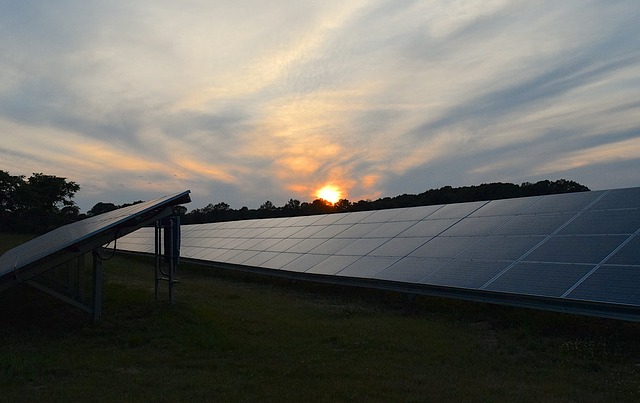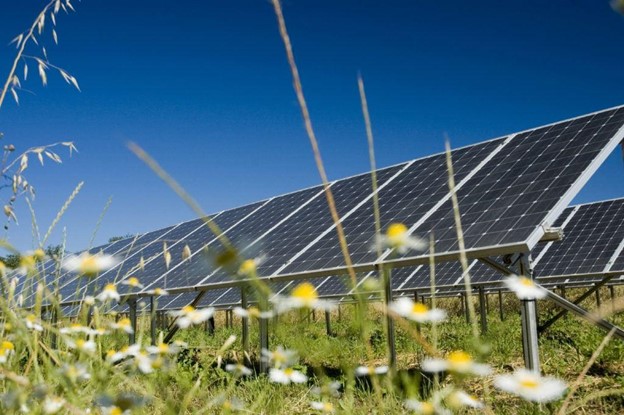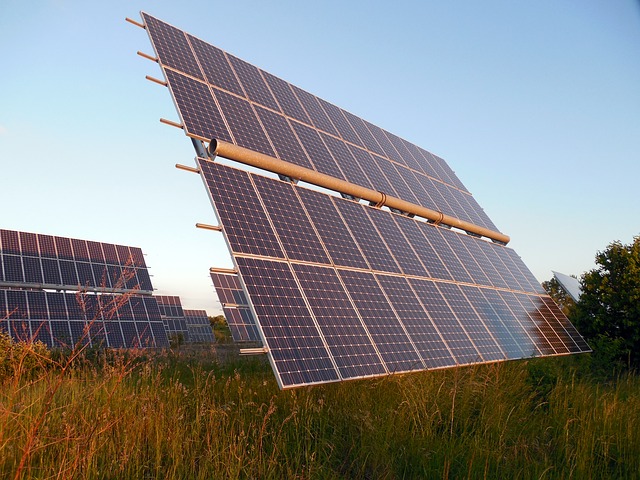Community solar in Maine
Community solar in ME is a new way to use solar energy available to people in Maine. It means everyone, not just property owners, can choose solar and reduce their energy bills. Community solar is the easiest way for every individual in Maine to take advantage of the shared benefits of renewable energy in their daily lives. It’s a utility-approved way to get credit on your monthly electricity bill.


Benefits of community solar in Maine
The state of Maine recently passed community solar legislation, making this energy option easier to access. Now people of all incomes and living situations have the choice for cheaper energy with less risk for the environment. Not everyone has the investment funds or rooftop requirements to install solar panels or wind turbines on their property. Nearly half of all households (49%) and businesses (48%) cannot support a PV system, according to a National Renewable Energy Laboratory study. This is why community solar is especially important for Maine’s residents and businesses. The nice thing about community solar in ME is you don’t have to own property or solar panels to get the benefits of renewable energy. Read on to learn how to tap into these benefits. Subscribing to community solar is really simple and it will save you money on your electricity bill.
What is community solar in ME and how does it work?
Community solar is not very different from buying electricity from a utility company. You still receive your regular utility bill, but subscribing to community solar changes the source of your energy from the standard energy mix to renewable solar energy. This reduces the cost of energy. Here’s how it works:- The electricity is produced at a solar farm in Maine.
- The solar farm delivers energy to the electrical grid for everyone to access.
- All you have to do is sign up as a subscriber to get credits from the renewable energy produced.
- Choose Solar calculates your solar usage and electricity cost savings for no cost.
- When you receive your normal utility bill, you’ll see your community solar savings deducted off the standard electricity price.
- Your electricity savings will range from roughly 5-10%, depending on the going rates at the time of your energy purchase.
Electricity rates in Maine
Maine’s electric bills are already low compared to the rest of the country, but they just got cheaper. On average, people in Maine pay $78 per month for electricity. This is 27.1% less than the US average monthly electric bill of $107. Since the annual cost of electricity in Maine is $936 on average, a 5% to 10% savings from community solar will save you about $47 to $94 each year. And this savings comes at no cost to you when you sign up with Choose Solar.The environmental impact of community solar in ME
Maine will reduce 1.5 million metric tons of carbon dioxide emissions per year by switching to 100% renewables by 2050. That’s an average of 0.9 metric tons per person annually. Community solar helps make the shift to renewables go swiftly.Who can sign up for community solar
The best part about community solar is anyone who pays an electric utility bill can join! Once again, you don’t have to own property, panels or pay for this subscription. All you have to do is purchase energy from a utility, and you can opt in to receive community solar credits for free. Community solar in ME gives access to people who couldn’t use renewable energy before:- Home renters
- Apartment renters
- Businesses leasing space
- Mobile home owners
- Home owners who can’t afford rooftop solar
Why utility-scale solar energy matters
Solar energy is by far the single most potent source of energy available to the world, with a theoretical potential of 89 terawatts. In one second, the sun supplies enough energy to meet the total global electricity demand for 2 hours. Yet, solar energy only accounts for about 2 percent of the total energy supply at the moment. This will drastically change in the future. To keep the world on track to keep the atmospheric temperature rise under 1.5 degrees Celsius by 2100, the second most impactful solution is utility-scale solar projects, according to Project Drawdown. This means community solar is part of a necessary shift towards reaching this internationally accepted target. It is part of a key solution to avoiding the worst societal impacts of climate change. Utility-scale solar projects can help remove roughly 43 to 199 gigatons of expected carbon dioxide emissions between 2020 and 2050. This is why Maine has prioritized this solution in its recent changes to legislation.
Advancing solar power in Maine
Energy independence is important for people in Maine, and solar energy is an increasingly cost-efficient and attractive option. Maine’s energy mix has always been diverse. Prior to 1999, the state used petroleum, coal, nuclear, hydropower, and biomass energy sources–thanks to its plentiful forests. Maine has historically had a relatively high ratio of renewable energy sources compared to other states. For the past 25 years, Maine already depended on renewable energy sources for roughly 40-45% of its power. Maine’s weather conditions are surprisingly suited to solar energy production. A solar panel system in Portland, Maine can produce 6 percent more energy on average than in Houston, Texas and just 5% less on average than in Miami, Florida. Given the historical embrace of diverse energy and the optimal conditions for generating solar power, there is no reason why Maine should hold off on developing solar to its full potential.Legislative Progress for Renewable Energy in Maine
Maine legislation recently reversed illogical barriers to solar access and growth, which has made community solar a viable option for everyone. Maine is now on a path to source 80% of its power from renewable energy by 2030, and 100% by 2050. Maine adopted these expanded targets with the passage of LD 1494, a piece of legislation that lifted the ceiling on Maine’s Renewable Portfolio Standard. There are obvious benefits of this heightened standard that will apply to everyone. The low cost of renewable energy means it benefits the economy, expanding solar will bring more jobs to the state, and the environmental benefits include both reducing climate risk and improving public health. Phasing out the unpredictable price variation of fossil fuels is a lesser-known benefit. When Maine relied on 40% fossil fuels, it had to both import those resources and endure its volatile price. Shifting to 100% renewable energy over the next 30 years will bring new green jobs to Maine, local energy independence, and tax revenue that will benefit rural communities in the state. By powering 80% of its retail energy needs with renewable energy by 2030 and then phase out the remaining 20% of non-renewable energy resources by 2050, Maine demonstrates a commitment to internationally agreed targets. Yet, energy is only one piece of the puzzle for Maine, there will still be more work to do in terms of transport. Nevertheless, a key ingredient to making the shift is solar energy. But to understand why solar energy is so important, we must look at the history of how Maine reached its decision to make this shift to 100% renewable energy.Maine’s Community Energy Pilot
Did you know that Maine’s legislature adopted a pilot for community-based energy in Maine over ten years ago? Maine foresaw the need for community-based renewable energy in 2009, when it gave local solar energy providers an opportunity to establish community solar farms. To qualify as a community solar farm in Maine in 2009, each project had to demonstrate that it was:- Community-based renewable energy with at least 51% local ownership
- Supported by local municipalities and tribes
- Interconnected to Maine’s energy grid
- First, local owners could sell their energy output to a utility at a variable cost of no more than $0.10 per kWh. This sale was counted as taxable income, as it did not include RECs.
- Second, the community energy is virtually net-metered to joint owners. The rate was proportional to their ownership amount.

Maine establishes public community solar access
This pilot program led to Maine’s 2019 legislation, LD 1711, which granted the public access to community solar benefits. Maine was the 21st state to offer community solar in ME access to its residents when this law passed. This community solar law means people living in any type of home can opt in to use solar energy. Prior to the community solar option, you had to purchase and install your own solar pv system onto your property. The problem with this approach is it excludes many low-income people, and it doesn’t redistribute the cost benefits of renewable energy. This is why the law also contains a requirement ensuring that 10% of each project built to reach its community solar goal of 250MW must provide energy to low- and moderate-income households in Maine. That reserves 25MW of the solar credit opportunity that community solar offers for people who need it most. The rest is available to anyone that pays an electric bill. This includes renters, households, businesses of all sizes, nonprofits, churches, and even towns. Maine hopes to distribute the benefits of renewable energy through a simple credit added to your existing utility bill.Expanded energy caps for solar in Maine
One of the major benefits of this law is it greatly expands the total installed energy capacity of solar energy in Maine. Communities and landowners can each install a project total of up to 5MW to build a combined 250MW of solar energy capacity in the state. In the previous pilot program, Maine had set a cap of 9 community solar net metering projects that could each only produce 660 kW in energy. But under the new law, LD 1711, the cap was raised to 200 projects producing up to 5KW.Net Energy Billing
The Net Energy Billing (NEB) details of LD 1711 establish the guidelines for providers to provide energy credit to residential or nonresidential customers. Under LD 1711, there are two forms of accessing credit from community solar projects:- The NEB kWh Credit Program is for everyone including residential customers to offset their energy bills using the kWh credits. Customers may own or share a project.
- The NEB Tariff Rate Program is for nonresidential customers (which can sell to subscribers) to access dollar credits on customers’ electricity bills. The tariff rate is predetermined for each year by the PUC. Customers may own or share a project with other commercial entities.
- Subscribing is the simplest way, since you just sign up online at no cost and start receiving the credits immediately and the developer receives the tax credits. The discounts you receive are based on the going tariff rate of electricity, but you won’t have to pay anything up front.
- Partial ownership is also available, but it usually involves an upfront purchase. Depending on the make-up of your ownership, there may be additional maintenance costs, but you can access the tax credits for your share of ownership and the rate of electricity is based on the kWh offset rate.
Maine net metering
Along with California and Massachusetts, Maine was one of the first states to offer virtual net metering as a means for issuing solar energy credits. In the past, utilities often argued that it put unnecessary costs onto users, while renewable energy developers tend to find it more suitable for investment in solar energy. Like traditional net metering, virtual net metering is how utilities and solar operators apply energy credits to utility bill payments. It allows a single renewable energy system to distribute cost savings to multiple electric accounts serviced by a utility. However, on the bumpy road to embracing renewable energy, Governor Paul LePage enacted “gross metering” in 2018. The problem with gross metering for solar energy is it charged people like homeowners and businesses for installing and producing solar energy, which de-incentivized this attractive energy option. However, the following year another legislation, LD 91, reversed this decision–an important return to net metering in Maine. Now, with the passage of LD 91, LD 1711 and LD 1494, there are numerous opportunities for growth in solar energy development. The best part about these laws is they ensure renewable energy access for everyone.Where will Maine’s solar projects get built?
One risk with any solar development opportunity is that it could replace resource-rich land such as forests or farmland. Responding to this risk, the law currently includes incentives for developing solar projects on land with less value to the community, such as landfills, rooftops or even empty lots. The location of large community solar projects depends on responsible decisions from developers. In Maine, various organizations are working to provide additional guidelines to ensure sites are selected responsibly. For example, the Maine Farmland Trust produced guidelines for farmland siting which include the following recommendations:- Avoid land designated as “prime farmland” or “farmland of statewide importance” by the Natural Resources Conservation Service Seek out previously-developed, disturbed, degraded, or unproductive property, such as gravel and sand pits and rooftops, to avoid the use of farmland
- Prioritize dual-use projects (for simultaneous energy and farmland productivity)
- Operate and build in ways that don’t degrade the potential agricultural land value in the future
- Avoid placing grid connections on agricultural land
- Use the energy produced to service the farm directly